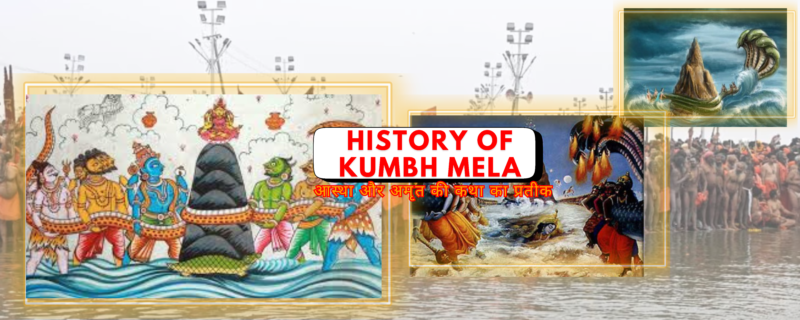The Mahakumbh Mela 2025 is not merely a religious gathering; it’s a profound cultural and spiritual phenomenon that unfolds once every 144 years. This extraordinary event, one of the largest human congregations on Earth, offers an unparalleled experience for devotees and curious travelers alike. Let’s delve into the history behind this sacred tradition and explore why the Mahakumbh Mela is an event worth witnessing.
Do you know the Rich History Behind Maha Kumbh Mela?
The Maha Kumbh Mela is one of the most celebrated spiritual events in the world, steeped in a history that dates back 1000 of years. This grand congregation is deeply rooted in Indian mythology, culture, and tradition, making it a fascinating event to explore. Here’s a closer look at its rich historical background:

Mythological Origins
- The origins of the Maha Kumbh Mela are linked to the story of the Samudra Manthan (churning of the ocean) from ancient Hindu texts.
- It is believed that drops of nectar, or Amrit, fell at four sacred locations—Prayagraj, Haridwar, Ujjain, and Nashik—while the gods and demons fought over it.
- These locations became the sites for the Kumbh Mela, where spiritual energy is said to be most potent.
Ancient Roots behind Kumbh
- References to the Kumbh Mela can be found in texts like the Rigveda and the Mahabharata, emphasizing its timeless significance.
- The event was formally organized during the reign of Emperor Harshavardhana in the 7th century CE, making it a historical gathering that has continued for centuries.
The Significance of 144 Years
- The Mahakumbh Mela 144 years tradition is based on celestial alignments that occur only once in a lifetime.
- This rare event magnifies the spiritual energy of the location, attracting millions of pilgrims seeking divine blessings.
Historical Pilgrimages and Traditions
- The Kumbh Mela has served as a unifying event for people across India, fostering cultural exchange and solidarity.
- Pilgrims from diverse backgrounds have historically gathered here to participate in rituals and ceremonies.
UNESCO Recognition
- Recognizing its historical and cultural significance, the Kumbh Mela was inscribed on UNESCO’s Representative List of the Intangible Cultural Heritage of Humanity in 2017.
- This acknowledgment highlights the global importance of preserving its rich heritage.
By understanding the deep history of the Maha Kumbh Mela, you gain a profound appreciation for its spiritual and cultural essence, making it an event worth witnessing.
Kumbh 2025: Why Are Bathing Rituals So Important?
The Kumbh 2025 bathing rituals hold immense spiritual significance for millions of devotees across the globe. This sacred act, known as “Snan,” is not just a ritual but a journey toward spiritual purification and salvation. Here’s why these bathing rituals are deeply revered:
Cleansing of Sins with Mythology
- Devotees believe that bathing in the holy rivers during Kumbh purifies the soul and washes away sins.
- The celestial alignment during the Kumbh Mela amplifies the spiritual energy, making this act even more powerful.
- The origin of Kumbh bathing rituals dates back to the Samudra Manthan .
- It is believed that taking a dip in the rivers where nectar of immortality (Amrit) fell connects devotees to this divine legend.
Path to Moksha with Collective Devotion
- Bathing during Kumbh 2025 is said to pave the way to Moksha, or liberation from the cycle of birth and death.
- Many saints, ascetics, and devotees undertake this sacred act to attain spiritual fulfillment.
- Millions gather at the Kumbh Mela, symbolizing unity and shared faith.
- The sight of devotees bathing together creates an unparalleled spiritual energy, fostering a sense of belonging and devotion.
Astrological Importance of this holy bath
- The timing of the bathing rituals is determined by specific planetary alignments, believed to enhance the sanctity of the act.
- These alignments are said to open celestial pathways, connecting the earthly realm with the divine.
Plan Your Visit to Experience Kumbh 2025 Bathing
The Kumbh 2025 bathing rituals are more than a tradition; they are a celebration of faith, history, and spirituality. Witnessing or participating in these sacred baths can be a transformative experience, making the Kumbh Mela a must-visit event for anyone seeking spiritual enlightenment.
Immerse Yourself in the Unique Blend of Faith and Tradition
The Maha Kumbh Mela 2025, a once-in-144-year event, offers a unique opportunity to immerse oneself in a profound blend of faith and tradition. This extraordinary gathering transcends religious boundaries, attracting millions of devotees from across India and the globe.
- A Sea of Humanity: The first day itself witnessed a remarkable turnout, with over 1.5 crore devotees converging on the sacred grounds.
- A Day of Sanctity: Makar Sankranti, celebrated on January 14th, marked a significant milestone with a massive congregation of pilgrims participating in the holy dip.
- A Global Tapestry: The Maha Kumbh Mela transcends geographical and cultural barriers, welcoming devotees from diverse backgrounds, including international pilgrims and tourists.
- A Modern Embrace: The event seamlessly integrates modern infrastructure with ancient traditions, utilizing digital tools and technology to enhance the overall experience for devotees.
Beyond its religious significance, the Maha Kumbh Mela is a vibrant tapestry of Indian culture, showcasing the nation’s rich heritage through music, dance, art, and cuisine.
FAQs about Mahakumbh Mela
Why is the Mahakumbh Mela 2025 a once-in-144-year event?
The 144-year cycle of the Mahakumbh Mela is believed to be linked to rare celestial alignments. These unique cosmic occurrences are thought to significantly amplify the spiritual energy at the Mela sites, attracting millions of pilgrims seeking divine blessings.
What is the spiritual significance of the bathing rituals at Kumbh 2025?
The “Snan” (holy bath) is a central ritual at the Kumbh Mela. Devotees believe that immersing themselves in the sacred waters of the Ganges River at specific auspicious times during the Mela purifies the soul, washes away sins, and can even pave the way to Moksha (liberation from the cycle of birth and death). The collective devotion of millions of bathers is believed to create a powerful spiritual energy.
What makes the Mahakumbh Mela a unique cultural experience?
Beyond its religious significance, the Mahakumbh Mela is a vibrant tapestry of Indian culture. It’s a kaleidoscope of colors, sounds, and sights. From mesmerizing folk dances and soulful music to intricate rituals and prayers, the Mela offers a captivating glimpse into the diverse cultural heritage of India.
Why should travelers consider visiting the Mahakumbh Mela?
The Mahakumbh Mela is a truly awe-inspiring spectacle. Even for those not seeking religious enlightenment, it offers a unique and unforgettable human experience. Witnessing the sheer scale of this gathering, with millions of people united in a shared purpose, is a profound and humbling experience. Moreover, the Mela provides a fascinating opportunity to immerse oneself in Indian culture and witness a living tradition that has been celebrated for centuries.
Conclusion
The Mahakumbh Mela 2025 is a testament to the enduring power of faith and tradition. It’s an event that transcends time, connecting generations to ancient beliefs and practices. Whether you seek spiritual enlightenment, cultural immersion, or simply a unique human experience, the Mahakumbh Mela offers an unforgettable journey.

